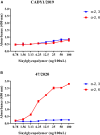Molecular Characteristics, Antigenicity, Pathogenicity, and Zoonotic Potential of a H3N2 Canine Influenza Virus Currently Circulating in South China
- PMID: 33767679
- PMCID: PMC7985081
- DOI: 10.3389/fmicb.2021.628979
Molecular Characteristics, Antigenicity, Pathogenicity, and Zoonotic Potential of a H3N2 Canine Influenza Virus Currently Circulating in South China
Abstract
Canine influenza viruses (CIVs) could be a source of influenza viruses which infect humans because canine are important companion pets. To assess the potential risk of H3N2 CIVs currently circulating in southern China to public health, biological characteristics of A/canine/Guangdong/DY1/2019 (CADY1/2019) were detected. CADY1/2019 bound to both avian-type and human-type receptors. CADY1/2019 had a similar pH value for HA protein fusion to human viruses, but its antigenicity was obviously different from those of current human H3N2 influenza viruses (IVs) or the vaccine strains recommended in the North hemisphere. CADY1/2019 effectively replicated in the respiratory tract and was transmitted by physical contact among guinea pigs. Compared to human H3N2 IV, CADY1/2019 exhibited higher replication in MDCK, A549, 3D4/21, ST, and PK15 cells. Sequence analysis indicated that CADY1/2019 is an avian-origin virus, and belongs to the novel clade and has acquired many adaptation mutations to infect other mammals, including human. Taken together, currently circulating H3N2 CIVs have a zoonotic potential, and there is a need for strengthening surveillance and monitoring of their pathogenicity.
Keywords: H3N2 canine influenza virus; HA stability; antigenicity; guinea pig; pathogenicity.
Copyright © 2021 Wu, Su, Gu, Yu, Li, Sun, Pan, Cui, Zhu, Yang, Liu, Xu, Li, Liu, Qu, Wu, Liao and Sun.
Conflict of interest statement
The authors declare that the research was conducted in the absence of any commercial or financial relationships that could be construed as a potential conflict of interest.
Figures






Similar articles
-
Increased public health threat of avian-origin H3N2 influenza virus caused by its evolution in dogs.Elife. 2023 Apr 6;12:e83470. doi: 10.7554/eLife.83470. Elife. 2023. PMID: 37021778 Free PMC article.
-
Pathogenicity and transmissibility of current H3N2 swine influenza virus in Southern China: A zoonotic potential.Transbound Emerg Dis. 2022 Jul;69(4):2052-2064. doi: 10.1111/tbed.14190. Epub 2021 Jun 23. Transbound Emerg Dis. 2022. PMID: 34132051
-
Characterization of Canine Influenza Virus A (H3N2) Circulating in Dogs in China from 2016 to 2018.Viruses. 2021 Nov 15;13(11):2279. doi: 10.3390/v13112279. Viruses. 2021. PMID: 34835084 Free PMC article.
-
H3N2 avian influenza viruses detected in live poultry markets in China bind to human-type receptors and transmit in guinea pigs and ferrets.Emerg Microbes Infect. 2019;8(1):1280-1290. doi: 10.1080/22221751.2019.1660590. Emerg Microbes Infect. 2019. PMID: 31495283 Free PMC article.
-
[Swine influenza virus: evolution mechanism and epidemic characterization--a review].Wei Sheng Wu Xue Bao. 2009 Sep;49(9):1138-45. Wei Sheng Wu Xue Bao. 2009. PMID: 20030049 Review. Chinese.
Cited by
-
Exploring Potential Intermediates in the Cross-Species Transmission of Influenza A Virus to Humans.Viruses. 2024 Jul 14;16(7):1129. doi: 10.3390/v16071129. Viruses. 2024. PMID: 39066291 Free PMC article. Review.
-
Transmission Pathways of Zoonotic Influenza Viruses and Influencing Factors: A Systematic Review of Recent Findings.Viruses. 2025 Jun 17;17(6):857. doi: 10.3390/v17060857. Viruses. 2025. PMID: 40573448 Free PMC article. Review.
-
Analysis of data from two influenza surveillance hospitals in Zhejiang province, China, for the period 2018-2022.PLoS One. 2024 Feb 28;19(2):e0299488. doi: 10.1371/journal.pone.0299488. eCollection 2024. PLoS One. 2024. PMID: 38416761 Free PMC article.
-
The genetic diversity, replication, and transmission of 2009 pandemic H1N1 viruses in China.Front Microbiol. 2023 Feb 17;14:1110100. doi: 10.3389/fmicb.2023.1110100. eCollection 2023. Front Microbiol. 2023. PMID: 36876101 Free PMC article.
-
Increased public health threat of avian-origin H3N2 influenza virus caused by its evolution in dogs.Elife. 2023 Apr 6;12:e83470. doi: 10.7554/eLife.83470. Elife. 2023. PMID: 37021778 Free PMC article.
References
-
- Alexander D. J., Brown I. H. (2000). Recent zoonoses caused by influenza a viruses. Rev. Sci. Tech. 19 197–225. - PubMed
LinkOut - more resources
Full Text Sources
Other Literature Sources

